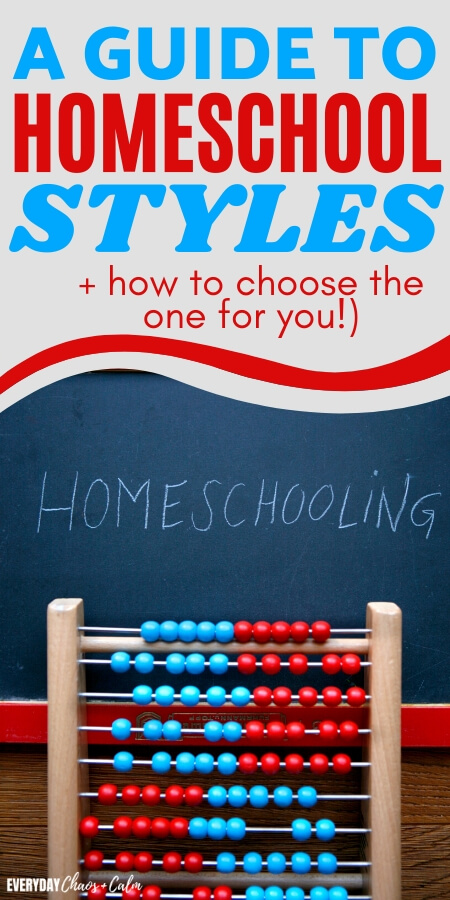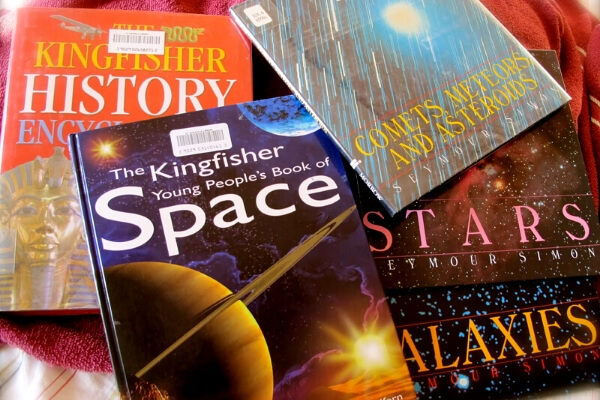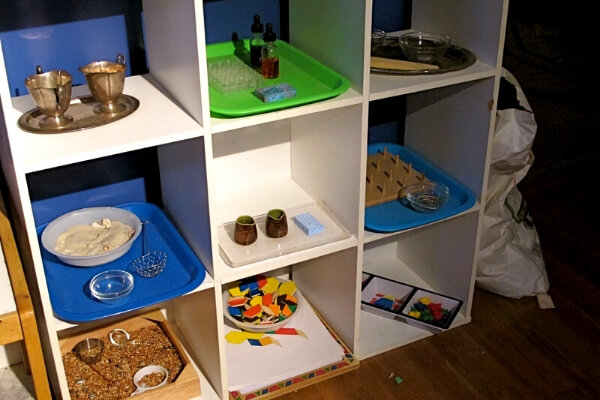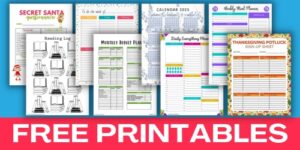Are you thinking about homeschooling your kids? Here is a quick look at 9 different homeschool styles and how to choose one that will work for you and your family.
When just starting out homeschooling can feel very overwhelming!
** This website contains affiliate links. If you make a purchase using one of these links, I may earn a commission. Please click here for more information about cookies collected and our privacy policy **.
Luckily, you aren’t alone and there are tons of resources and educational tools to help you on your journey.
But before you start homeschooling, you should take some time to familiarize yourself with the different homeschool styles and methods of educating from home.
Here is a quick look at nine different methods, including some pros and cons of each, to help you decide which method is best for you and your kids.
A Quick Look at 9 Different Homeshool Styles
School at Home
School at home is exactly as it sounds. In this homeschool style, parents recreate the school experience exactly as it would happen in a tradition public or private school setting.
Many first generation homeschoolers use this at first simply because it’s familiar. It’s how they learned as a kid and it feels like “the way school is supposed to be”.
School at home might mean:
- Setting up a “school room” complete with desks, supplies, posters, etc.
- Using a boxed curriculum of textbooks, worksheets, tests, and quizzes
- Having a strict class schedule during the day, just as you would in traditional school
Pros:
The biggest benefit of school-at-home is that it is familiar, especially if you are starting to homeschool after your child has already been to public school.
You also don’t have as many decisions to make. You can choose a boxed curriculum that gives you everything you need for every subject, including teachers guides. Some options also include virtual instructions from other teachers.
Most curriculum will align with current standards and you won’t have to worry about being behind if you put your child back into public school or that there will be any holes when it comes down to things like standardized tests.
Cons:
Some cons for the school-at-home style of homeschooling is that it is very inflexible and expensive.
Many parents- and kids- who use this method end up feeling burned out with the amount of time and work needed to complete the curriculum.
And finally school at home tends to have much longer school days than other homeschool styles.
While many homeschoolers may start off using a school-at-home model, after they gain confidence with homeschooling they leave it behind for other methods of teaching that offer more freedom.
Virtual School/Online Homeschooling
Virtual School or Online homeschooling isn’t really homeschooling at all.
It’s actually public school at home.
Your public school provides the materials, curriculum, and often, the instruction, in a virtual format.
Pros: The main pro for virtual homeschooling is that it is often free. You don’t have to worry about anything other than making sure your child completes his lessons.
Cons: The cons are that you don’t have the freedom to veer from the lessons and curriculum given to you. The time required is also greater than many other homeschooling options.
Classical Homeschooling
The classical homeschooling style is a time-tested education model that’s been around since the Middle Ages.
Classical homeschooling is all about training the mind and teaching how to learn for themselves.
Classical homeschooling focuses on 3 main stages of learning:
- The Grammar Stage – K-5. This stage focuses mainly on the 3 R’s of reading, writing, and arithmetic. There is a strong focus on memorization and repetition for all subjects.
- The Logic Stage – Middle School Age. At this stage students start to think more independently and begin to ask more questions. They learn how to use argument and logic to organize and learn information.
- The Rhetoric Stage – High School Age. This final stage builds on the previous stages as the student combines the foundation and critical thinking skills they have learned. They learn how to articulate their conclusions in verbal and written form.
One of the most popular classical education resources for homeschoolers is The Well Trained Mind.
Pros:
This biggest benefit of using a classical homeschooling style is that it is time-tested and proven to provide an excellent education.
Your kids will have a strong foundation in all subject matters.
Classical education has a strong focus on reading- and reading real books and literature.
Since it is a popular homeschooling method, there are a lot of resources and pre-made curricula available for you to purchase and use.
Cons:
While reading is a benefit, the amount of reading required in classical education can also be a drawback. This can be especially negative if your child struggles with reading.
Classical homeschooling can also be more rigid, with less flexibility than other homeschooling styles.
It also doesn’t always take into account the individual learning styles of kids, which can affect the effectiveness of the education.
Unit Studies
Unit studies are a way of learning where you and your kids will study one topic or theme at a time. This same theme will be carried through each subject.
For example, if you were doing a unit study on any given subject, you might:
- Read books on the subject- as both read alouds and silent reading
- Write a story, essay, or research paper on the topic
- Watch a documentary
- Take a field trip
- Conduct a science experiment
- Build a model
- Learn new vocabulary words
In this way you can incorporate reading, vocabulary, science, math, etc. all while diving deep on one particular subject.
This homeschooling style is very popular, especially for those with young kids or multiple ages.
Pros:
Some of the pros of using unit studies include:
- It’s fun! Especially if it’s a topic that your child is passionate about.
- It’s very hands on
- Great for multi-age families who want to learn together for many subjects
- Fosters a love of learning
Cons:
Creating unit studies can be very time consuming, and even if you purchase one, setting up and completing all of the projects and activities can be overwhelming.
Unit studies can be somewhat incomplete, which can also lead to holes and gaps in knowledge.
Montessori Style
The Montessori method of education was created by Maria Montessori in the early 20th century. It is a child-centered approach to learning that focuses on creativity and curiosity to lead the child to learn and seek out knowledge.
Montessori schools focus on real tools that are kept organized and ready to use. Teachers tend to be hands off and see themselves as facilitators instead of instructors.
While Montessori methods were created for a school setting, over the years many homeschoolers began to adopt aspects of the method and recreated it for a homeschool setting.
This includes setting up your home in a way that encourages learning and displaying quality materials at the child’s level where they are available at all times.
Pros:
Some pros of using a Montessori inspired homeschool style is that it is very child focused, meaning it takes into account the fact that young learners need to move, touch, and play while they learn.
It also encourages the learning of life skills, which is a very important part of education.
The Montessori inspired homeschool style give children freedom to learn how and what they desire.
Cons:
Since Montessori is more of a philosophy than a defined program, which means there is no set curriculum for parents.
True Montessori education requires a certified teacher, so it cannot be truly replicated in the home without gaining certification yourself.
Montessori materials can be expensive, though you can set up your home using their materials as a guide.
Montessori education can be used for all ages, but it is best suited for younger, elementary aged children.
Waldorf Style
Waldorf education is based on the work of Rudolf Steiner. This education model focuses on education the whole child- mind, body, and spirit.
This method does not use television, computers or standard text books.
There is an emphasis on art, music, and nature and encourages learning through exploration and play.
Pros:
Some of the pros for Waldorf-inspired homeschooling is that it de-emphasizes academics in early childhood and instead focuses on age appropriate learning.
The rhythm of a Waldorf school day flows easily, while allowing plenty of time for life and learning to coexist.
Since nature is a large part of Waldorf education, curriculum can be very inexpensive.
Cons:
There can be a big learning curve when learning about how to teach using the Waldorf methods.
It can also feel like a big life style change for those who are new to this way of education.
Whether you are a religious or secular homeschooler, you should read up on the religious and spiritual aspects of Waldorf learning to make sure they align with your particular beliefs.
Unschooling
Unschooling is a homeschooling style that is child-led and interest-led. Parents trust that the child will learn organically as the pursue their own passions and interests.
Similar to the way a child learns to walk and talk naturally without any instruction, an unschooler will learn similarly to the way we learn as adults simply by pursuing interests.
Unschooling can seem like a very abstract concept, especially for those who were a product of a traditional education and have a very specific idea of what “school” should look like.
Unschooling doesn’t mean that you are totally hands off, that there is no direction at all from parents, or that the child is allowed to do whatever he pleases at all times.
Pros:
The pros of unschooling are that it:
- Is passion driven. It allows kids to follow their passion and learn a subject deeply and thoroughly.
- Is adaptable. Because there are no strict rules, schedules, timelines, or academic markers you can adapt the education in as many ways as you can imagine.
- Produces life long learners who LOVE to learn. Without being bogged down with academic benchmarks, you won’t zap the life out of learning
This method is also great for anyone who thinks that most of what is taught in school is unnecessary or useless information. It’s also great for students that are self starters, those with an entrepreneurial spirit, or tend to create and take on projects for themselves.
Cons:
One of the biggest drawbacks to unschooling is that children don’t learn the same things at the same time as traditionally schooled kids. If you plan on homeschooling through high school, that’s not necessarily a problem, but if you want to re-enroll in school your child may be ahead in some subjects and way behind in others.
The lack of structure can be a problem for some kids and some parents.
Charlotte Mason Style
Charlotte Mason was a late 19th century educator who devoted her life to improving the quality of children’s education. This homeschooling style is about educating the whole child- not just the mind, or in her own words, “Education is an Atmosphere, a Discipline, a Life.”.
Charlotte Mason homeschooling method includes:
- Narration- where the child repeats back what they have learned either orally or by writing
- Copywork- by copying literature students are taught things like handwriting and spelling
- Nature study- studying living science through nature walks and observation; creating your own nature journal
- Living books- reading is a big part of the CM homeschooling style. Reading real books written by authors who are passionate about a subject (as opposed to dry Textbooks)
Pros:
The Charlotte Mason homeschooling style takes some of the best parts of some of the previous homeschooling styles and blends them together to form a teaching and learning method that works for both parents and children.
It is fairly inexpensive- with many free or inexpensive resources on sites such as SimpyCharlotteMason and Amblesideonline.
It is also a time-tested education method that has been used successfully for over 100 years.
But one of the best benefits of CM homeschooling is that it encourages a love of books and learning, by keeping children engaged and excited about learning.
Cons:
Some of the drawbacks for this homeschooling style are:
- There isn’t an emphasis on subjects such as math or advanced science.
- It was originally designed and used for K-6 students, which means using this method in the upper middle school and high school grades is harder, with less resources available.
- If you are a secular homeschooler you may find it hard to find resources that are non-Christian and are neutral when it comes to religion.
Eclectic Homeschooling
And finally, eclectic homeschooling. This is the most popular homeschooling method and the one I myself have used for the past 14 years.
Simply put, the eclectic homeschooling style is a mix and match approach based on each individual family that takes into account the teaching style of the parent and the learning style of the student.
In other words, you can pick and choose bits and pieces of the previous homeschooling styles and mix them together to form your own individualized plan.
For example, in our homeschool, we have used:
- Unit studies for multi-age learning to cover subjects such as writing, reading, art, and science.
- School-at-home style textbooks for math and high school level science
- Montessori inspired materials for preschool-preK
- Classical education for studying history
- Unschooling (or LIFEschooling) to learn elementary science topics based on interest
- Used “Living Books” to learn and enjoy all sorts of topics
And most of those went on at the same time.
Pros:
One of the benefits of being an eclectic homeschooler is that it’s very flexible. You aren’t pressured to stick to one school of thought and can change things as needed to suit your family. You can also change year to year or as needed to suit the family needs.
Since it’s a popular homeschooling style, it’s easy to find resources and support groups to help you as you navigate educating your children at home.
And my favorite- it takes into account the child, and how they learn. Each child is unique and eclectic homeschooling allows you to tailor your teaching to take into account learning styles, teaching styles, personality, interests, and strengths.
Cons:
It can be overwhelming to piece together a curriculum from scratch. There are so many options and you may feel like you have to test all of them before finding just the right fit.
How to Choose Which Homeschool Style is Right for You
So now that you know about all the different types of homeschooling styles, how do you decided which one is right for you and your family?
Here are a couple of questions to ask yourself before trying to decide which will work best for you:
What does your education philosophy look like?
Do feel that academics is the most important part of education? Is getting into a IVY league college a goal you have for your kids?
Some of the homeschooling styles are very focused on academics, while others focus more of fostering a love of learning and interest-led exploration.
Be sure to choose a style that works with your feelings on this topic.
What are your long term homeschooling goals?
Take some time to write out your long term homeschooling goals for your kids. What do they look like?
Then choose a homeschooling style that helps you reach those goals.
What is your teaching style?
Teaching style is just as important as learning styles. Make sure you take into account the teacher’s role when choosing a homeschool style.
What is your child’s learning style?
Is your child a visual, auditory, or kinesthetic learner? Make sure to choose one that will work with how he learns or school might be a life long fight.
How long do you plan on homeschooling?
While many homeschoolers take it one year at a time, if you KNOW you won’t be homeschooling long make sure you choose a homeschool style that will make it easy to acclimate back into a public or private school setting.
The good thing about homeschooling is that you aren’t stuck in any one decision. If you start off with one homeschooling style and then realize it’s just not working, you have the freedom to change directions and go in a different way. So don’t worry too much about “choosing wrong” because, even if you do, it’s okay and you can always change your mind!
Once you’ve decided on a style, make sure you keep organized with our printable homeschool attendance sheets!










I didn’t even know there were so many styles. Charlotte Mason Style is probably the most popular, at least among the parents I know. Our homeschooling is more intuitive, trial and error, and has lots of approaches. But I should probably delve a little more into the different styles.